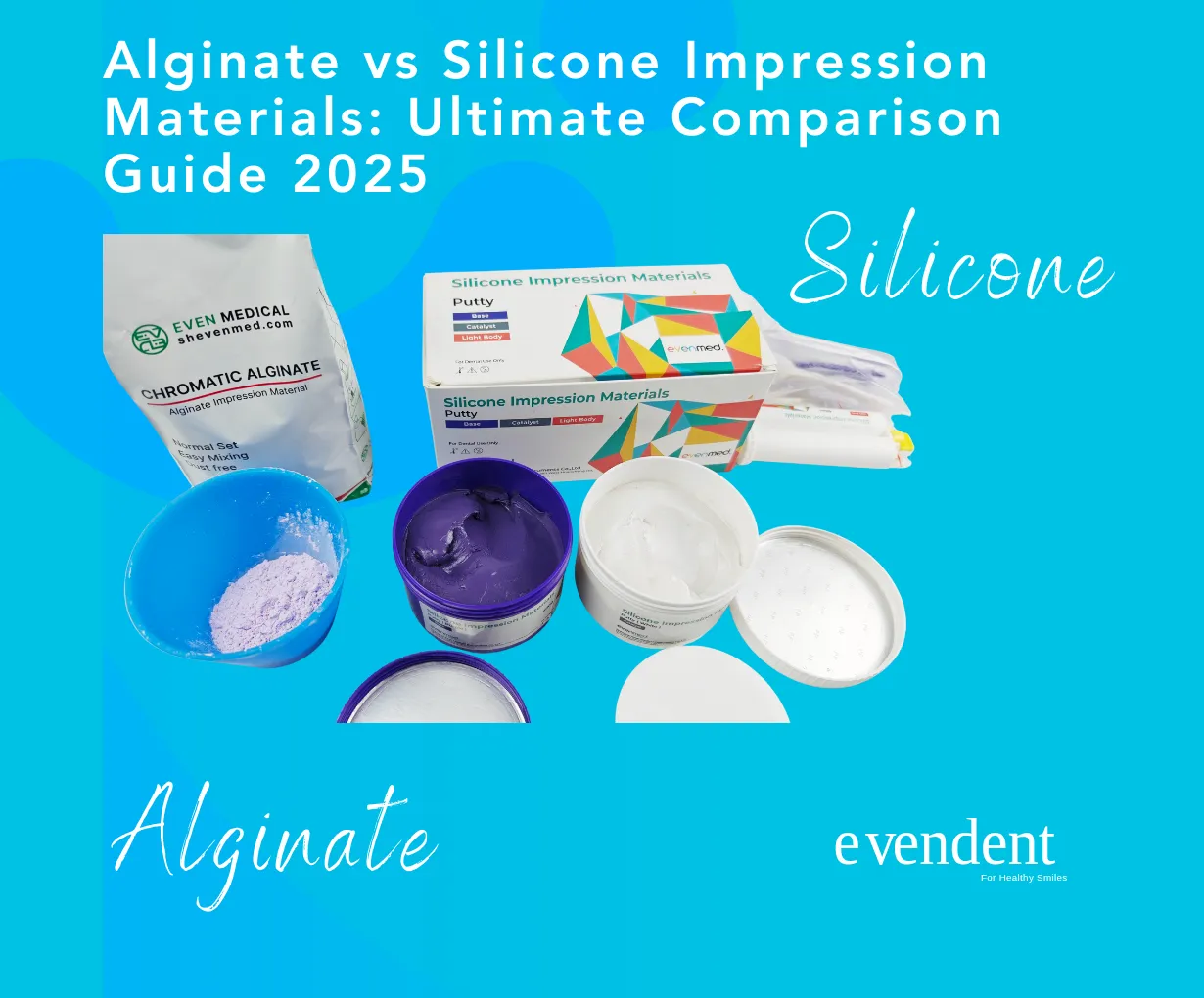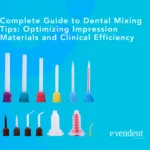Alginate vs Silicone Impression Materials represents one of the most critical decisions in modern dental practice. With material costs impacting profitability and accuracy affecting clinical outcomes, understanding the comprehensive differences between these two primary impression material categories ensures optimal patient care and practice efficiency. This evidence-based comparison guide provides detailed analysis to help dental professionals make informed material selection decisions.

Understanding the Fundamental Differences
Chemical Composition and Setting Mechanisms
Alginate (Irreversible Hydrocolloid)
- Base Material: Sodium alginate derived from seaweed
- Setting Reaction: Calcium-sodium ion exchange creating flexible gel matrix
- Setting Time: 3-6 minutes with visual confirmation
- Irreversible: Cannot be remelted or reused
Silicone (Elastomeric Polymer)
- Base Material: Polyvinylsiloxane (addition) or polydimethylsiloxane (condensation)
- Setting Reaction: Polymerization with platinum catalyst
- Setting Time: 4-8 minutes depending on viscosity
- Stable: Maintains dimensional accuracy over time
Physical Properties Comparison
| Property | Modern Alginate (EvenDent) | Silicone (VPS) | Clinical Impact |
|---|---|---|---|
| Detail Reproduction | 20-50μm | 20-25μm | Both suitable for most applications |
| Dimensional Accuracy | ±50μm | ±25μm | Silicone slightly superior |
| Tear Strength | 0.38-0.48 N/mm | 1.5-3.0 N/mm | Silicone better for thin margins |
| Elastic Recovery | 97-98% | 99.5% | Minimal clinical difference |
| Working Time | 1.5-4 minutes | 2-5 minutes | Alginate offers faster procedures |
| Dimensional Stability | 168 hours | 2+ weeks | Silicone for delayed pours |

Cost Analysis: Real Numbers That Matter
Material Cost Breakdown
Alginate Cost Structure
- EvenDent Universal: $0.18 per impression
- EvenDent High Precision: $0.28 per impression
- EvenDent Super High Precision: $0.42 per impression
- Average mixing time: 30 seconds
- Total procedure time: 3-4 minutes
Silicone Cost Structure
- Light body VPS: $1.60 per cartridge
- Heavy body VPS: $1.60 per cartridge
- Total per impression: $3.20
- Mixing time: Automix (instant)
- Total procedure time: 6-8 minutes
Annual Cost Comparison for Different Practice Types
Small Practice (500 impressions/year)
- All Alginate Strategy: $90-210
- All Silicone Strategy: $1,600
- Potential Savings: $1,390-1,510 annually
Medium Practice (2,000 impressions/year)
- Mixed Alginate Strategy: $400-600
- All Silicone Strategy: $6,400
- Potential Savings: $5,800-6,000 annually
Large Practice (5,000 impressions/year)
- Optimized Alginate Primary: $1,000-1,500
- All Silicone Strategy: $16,000
- Potential Savings: $14,500-15,000 annually
Clinical Application Guidelines
When to Choose Alginate
Ideal Applications:
- Diagnostic Models – Study casts and treatment planning
- Orthodontic Records – Progress models and retainer fabrication
- Opposing Arch Impressions – Bite registration support
- Temporary Restorations – Provisional crown fabrication
- Pediatric Procedures – Fast setting, pleasant taste
- Removable Prosthetics – Preliminary impressions
- Sports Guards – Custom mouthguard fabrication
Clinical Advantages:
- Hydrophilic nature captures detail in moist environments
- Fast setting reduces chair time and patient discomfort
- Pleasant taste and smell improve patient acceptance
- Cost-effectiveness for high-volume procedures
- No mixing equipment required
When to Choose Silicone
Ideal Applications:
- Implant Impressions – Maximum accuracy required
- Multiple Unit Bridges – Complex fixed prosthodontics
- Full Arch Rehabilitation – Comprehensive cases
- Cosmetic Veneers – Ultra-precise margins needed
- Cases Requiring Multiple Pours – Laboratory flexibility
- Long-Distance Laboratory – Extended stability needed
Clinical Advantages:
- Superior dimensional stability for delayed pours
- Excellent tear strength for deep undercuts
- Multiple viscosity options for various techniques
- Automatic mixing reduces variables
- Hydrophobic versions available for dry field
Accuracy Comparison: Clinical Reality vs Marketing Claims
Margin Definition and Detail Reproduction
Modern Alginate Performance
- EvenDent chromatic alginate: 20μm particle size
- Clinical margin definition: Excellent for 95% of cases
- Suitable for single crowns with proper technique
- Captures fine detail when properly handled
Silicone Performance
- Premium VPS materials: 20-25μm detail reproduction
- Marginal superiority in laboratory studies
- Clinical significance minimal for most procedures
- Premium accuracy comes at 10-18x cost increase
Real-World Accuracy Factors
Technique Impact > Material Choice
- Proper tissue management: 40% of accuracy
- Adequate moisture control: 30% of accuracy
- Correct tray selection: 20% of accuracy
- Material quality: 10% of accuracy
Patient Experience Comparison
Comfort and Acceptance Factors
Alginate Patient Benefits
- Pleasant light fragrance options
- Faster setting reduces gag reflex
- Cooler temperature sensation
- Natural, non-synthetic feel
- 3-minute total chair time
Silicone Patient Experience
- Neutral taste and odor
- Longer setting time challenges
- Warmer sensation during setting
- Synthetic texture some find unpleasant
- 6-8 minute chair time
Pediatric Considerations
Alginate Advantages for Children
- Quick 3-minute setting crucial for cooperation
- Pleasant flavors available
- Lower material volume reduces gagging
- Cool sensation well-tolerated
- Staff familiarity improves success
Silicone Challenges with Children
- Extended setting time problematic
- Higher material volume
- Synthetic taste/texture issues
- Higher remake rates due to movement
- Cost prohibitive for routine procedures
Workflow Integration and Efficiency
Time Analysis per Procedure
Alginate Workflow Timeline
- Tray selection: 30 seconds
- Material measurement: 20 seconds
- Mixing: 30 seconds
- Loading tray: 20 seconds
- Impression taking: 3 minutes
- Total: 4 minutes
Silicone Workflow Timeline
- Tray selection: 30 seconds
- Adhesive application: 2 minutes (drying)
- Material preparation: 30 seconds
- Loading tray: 30 seconds
- Impression taking: 5-6 minutes
- Total: 8-9 minutes

Staff Training Requirements
Alginate Training Needs
- Basic mixing technique: 2 hours
- Chromatic timing mastery: 1 hour
- Troubleshooting: 1 hour
- Total training: 4 hours
Silicone Training Requirements
- Gun operation and maintenance: 2 hours
- Multi-viscosity techniques: 4 hours
- Adhesive protocols: 2 hours
- Advanced techniques: 4 hours
- Total training: 12 hours
Environmental and Sustainability Comparison
Ecological Impact Assessment
Alginate Environmental Profile
- Biodegradable natural material
- Minimal packaging waste
- No special disposal requirements
- Carbon footprint: Low
- Renewable resource base
Silicone Environmental Concerns
- Non-biodegradable synthetic polymer
- Significant packaging waste (cartridges, tips)
- Special disposal considerations
- Carbon footprint: High
- Petroleum-based materials
Decision-Making Framework
Practice Type Recommendations
General Practice Optimal Strategy
- 70% EvenDent Universal Alginate
- 20% EvenDent High Precision Alginate
- 10% Silicone for complex cases
- Annual savings: $8,000-12,000
Prosthodontic Specialty Practice
- 30% EvenDent Super High Precision Alginate
- 70% Silicone for complex rehabilitations
- Balanced quality and economics
Pediatric/Orthodontic Practice
- 95% EvenDent Universal Alginate
- 5% Alternative materials as needed
- Maximum efficiency and patient comfort

Clinical Decision Algorithm
Is this a routine diagnostic impression?
├─ YES → EvenDent Universal Alginate ($0.18)
└─ NO → Continue
│
Is this a single crown/simple bridge?
├─ YES → EvenDent High Precision Alginate ($0.28)
└─ NO → Continue
│
Is maximum accuracy critical?
├─ YES → Continue
│ │
│ Multiple pours needed?
│ ├─ YES → Silicone VPS ($3.20)
│ └─ NO → EvenDent Super High Precision ($0.42)
└─ NO → EvenDent High Precision Alginate ($0.28)
Quality Outcomes: Evidence-Based Comparison
Remake Rate Analysis
Modern Alginate Performance
- EvenDent products: 4% remake rate
- Proper technique critical
- Chromatic timing reduces errors
- Cost per remake: $0.18-0.42
Silicone Performance
- Premium VPS: 2% remake rate
- Technique more forgiving
- Extended working time helps
- Cost per remake: $3.20
Clinical Success Factors
Achieving Optimal Results with Alginate
- Use chromatic timing technology
- Maintain proper powder/water ratios
- Control storage environment
- Follow manufacturer guidelines
- Implement quality protocols
Maximizing Silicone Success
- Ensure thorough adhesive drying
- Avoid contamination
- Use appropriate viscosity combinations
- Maintain equipment properly
- Monitor material expiration
Advanced Considerations
Digital Workflow Integration
Alginate in Hybrid Workflows
- Physical impression for patient comfort
- Digital scanning of models
- Cost-effective digitization pathway
- Maintains clinical flexibility
Silicone Digital Advantages
- Direct scannable surfaces
- CAD/CAM compatibility
- Premium digital workflows
- Higher initial investment
Future Technology Trends
Alginate Innovation Pipeline
- Smart materials with environmental response
- Enhanced antimicrobial properties
- Improved dimensional stability
- Sustainable packaging solutions
Silicone Development Focus
- Faster setting formulations
- Improved hydrophilicity
- Cost reduction efforts
- Biodegradable alternatives
Conclusion: Making the Right Choice
The alginate vs silicone decision ultimately depends on specific clinical requirements, practice economics, and patient demographics. Modern alginate materials like EvenDent’s chromatic series have narrowed the performance gap significantly while maintaining substantial cost advantages.
Key Selection Principles:
- Match material to clinical need – Avoid over-engineering solutions
- Consider total procedure cost – Time, materials, and remakes
- Evaluate patient comfort – Faster procedures improve satisfaction
- Assess practice workflow – Integration efficiency matters
- Monitor quality outcomes – Track remake rates and success
For 85% of dental impressions, modern chromatic alginate provides optimal balance of quality, efficiency, and economics. Reserve premium silicone for the 15% of cases truly requiring maximum dimensional stability or multiple pours.
Transform Your Practice with Smart Material Selection
Ready to optimize your impression material strategy? EvenDent’s revolutionary chromatic alginate series delivers silicone-quality results at alginate prices.
Why EvenDent Chromatic Alginate?
✅ 20μm Ultra-Fine Particles – Match silicone detail at fraction of cost
✅ Visual Timing Technology – Eliminate guesswork with color indicators
✅ 97–98% Elastic Recovery – Exceptional accuracy for all procedures
✅ 3-Minute Setting Time – 50% faster than silicone alternatives
✅ $0.18–0.42 Per Impression – 85–95% cost savings vs silicone
Calculate Your Savings
Quick ROI Calculator:
- Current silicone impressions/month: _____ × $3.20 = $_____
- With EvenDent alginate: _____ × $0.28 = $_____
- Monthly Savings: $_____
- Annual Savings: $_____
Get Started Today
📞 Expert Consultation: +86-180-1638-1172
🟢 WhatsApp Support: +86-180-1638-1172
🌐 Learn More: evendent.com
📧 Free Practice Analysis: shevendent@gmail.com
Special Offer: Request free samples of all three EvenDent chromatic alginate types and experience the difference in your practice.
References:
- Journal of Prosthetic Dentistry – Impression Material Comparison Studies
- Dental Materials – Physical Properties and Clinical Performance
- Clinical Oral Investigations – Accuracy Studies of Impression Materials
- International Journal of Prosthodontics – Material Selection Guidelines
- ADA Professional Product Review – Impression Materials Database
- European Journal of Prosthodontics and Restorative Dentistry



